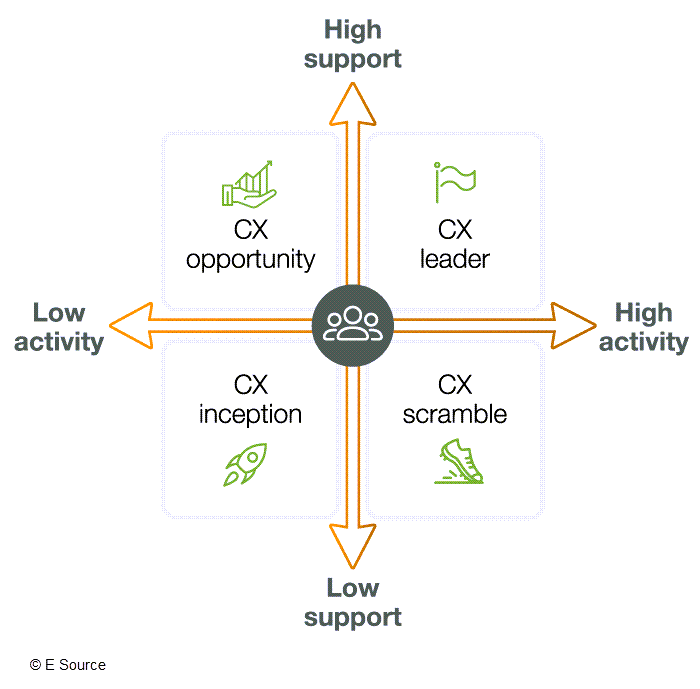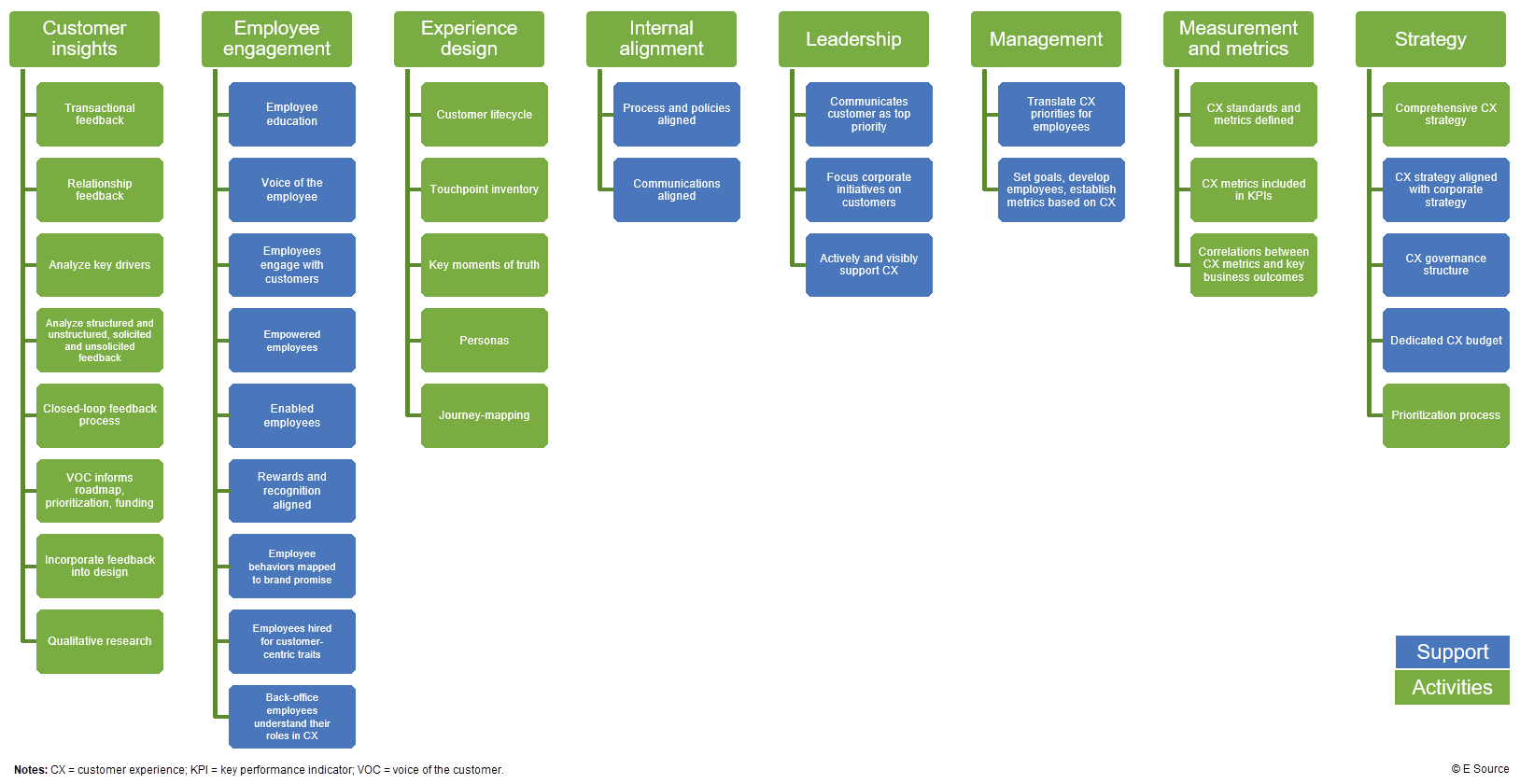Before you take the next step on your customer experience (CX) journey, you need to know where you’re standing. Take the E Source CX Maturity Assessment, which we’re updating in 2022, to learn the current state of your CX efforts. Then read this report to figure out what your results mean and what action you can take to move your customer experience forward.
What the CX maturity matrix is
E Source developed the maturity matrix as a way for utilities to measure and track their CX efforts. The matrix consists of four quadrants, each representing a different state of CX maturity. Using the CX Maturity Assessment, we score utilities and plot them onto the matrix. In the matrix, maturity is based on two key criteria for CX success: support and activities.
The E Source CX maturity matrix
Definitions and examples of “support” and “activities” in the E Source CX maturity matrix
| Component | Definition | Examples |
|---|---|---|
| © E Source | ||
| Support | The techniques, tactics, and strategies done primarily to embed customer-centric mindsets and behaviors into the culture and operations of the organization; generally, support is internally focused |
|
| Activities | The techniques, tactics, and strategies done primarily to improve the customer’s experience; generally, activities are externally focused |
|
We recognize that there’s often overlap between these primary categories. Some activities, such as sharing voice-of-the-customer insights with employees, are critical to improving the customer experience as well as increasing support for CX. One of the most effective strategies for increasing support, especially early on, is to obtain quick wins—that is, low-effort activities that quickly get positive results.
What the CX maturity quadrants represent
Each quadrant of the matrix represents a different state of CX maturity. If you’ve already taken the assessment, you’ve seen your results plotted on the matrix and know where your utility stands. You’ve also received recommendations of E Source content that will aid in advancing your maturity. Below we detail each quadrant of the matrix, identifying its most pressing challenges as well as actions you can get started on.
CX inception
This state represents organizations that may just be getting started with CX, with few activities in progress and little support for their efforts. Utilities falling in this quadrant are not alone. Seventy-five percent of utilities that responded to the E Source Customer Experience Survey 2016—the precursor to the current maturity assessment—indicated they’d been focusing on CX for less than five years. This shows that the majority of utilities are just embarking on their CX efforts and are facing a lot of work to build momentum and implement meaningful changes within their organization.
Seventy-five percent of utilities that responded to our survey indicated they’d been focusing on CX for less than five years.
Challenges to overcome. Inception utilities need to increase support for CX and launch activities related to CX improvement.
What to do first. We recommend first focusing on building up internal support for CX. Applying change management principles to gain support is a key ingredient to CX success. Additionally, utilities in this quadrant should focus on a few carefully chosen, low-effort activities that can make a positive impact quickly.
CX scramble
Utilities in this quadrant are facing the difficult challenge of winning support for CX. While these utilities may be pushing forward a variety of activities aimed at improving CX, executives and other departments are not fully on board yet.
Challenges to overcome. Scrambling utilities need to gain executive support, shift to a customer-focused culture, and overcome the culture of “no.”
What to do first. Tackle this problem via multiple approaches. Apply change management principles to build greater support. Use the voice of your customers to communicate the need for improved CX. Work on getting employees and middle management engaged with CX. Obtain dedicated funding for CX. Understand how your utility’s culture supports or works against CX.
CX opportunity
Utilities in this quadrant are in a promising position. Though a number of recommended CX activities are not yet under way, the high level of internal support for CX positions you well to move more CX initiatives forward.
Challenges to overcome. Utilities with CX opportunities need to harness their internal support into making CX improvements.
What to do first. If you haven’t created a CX strategy and customer promise, start there. Use the E Source template Utility customer experience strategy template (DOC) and our report Your guide to writing a CX intent statement to inform your path forward. You’ll also want to prioritize CX initiatives and create a CX roadmap.
CX leader
Utilities in this quadrant have done a lot of work to make customer experience an integral part of how they do business. They have strong internal support for their CX efforts and have taken steps to create a great experience for their customers. Customers may not yet be enamored of your business, but you have created an atmosphere to get to this place.
Leader utilities have strong internal support for their CX efforts and have taken steps to create a great experience for their customers.
Challenges. Leading utilities need to maintain CX momentum, including getting adequate resources and supporting a customer-centric culture.
Action items. Keep executive sponsors engaged and continue reinforcing customer-centric behaviors.
Why utilities should measure CX maturity
CX maturity is a leading indicator that will direct you to the CX results you want, rather than a reflection of what customers have already experienced. Leading indicators are measures that allow you to predict if you will meet a goal. Their counterpart, lagging indicators, tell you if you’ve achieved that goal.
Say you’ve always dreamed of climbing Denali. Before you book your plane ticket to Alaska, you’ll want some indication that you stand a good chance of making it to the top of the mountain. You can measure this with leading indicators.
Reaching CX maturity is like climbing Denali
| Support involved in climbing Denali | Activities involved in climbing Denali |
|---|---|
| © E Source | |
| Equipment: Ensure you have the right equipment to accomplish your goals. For example, do you have the right-size backpack, clothing for adverse conditions, and shoes that won’t give you blisters? | Doing fitness training: Have you completed practice climbs of other mountains, done strength training to prepare yourself to carry a heavy pack, and tested your lung capacity? |
| Funding: Do you have the funds to fly to Alaska, take time off of work, and pay for the equipment, food, and guidance necessary? | Honing wilderness skills: Have you developed basic outdoor competencies like building a fire, finding water, cooking outdoors, and knowing how to deal with emergencies like injuries or storms? |
| Basic ability: Are you physically able to take on a multiweek hike at altitude or are there any underlying issues that would prevent this? | Researching: Are you building out an itinerary, learning the route, hiring a guide? |
Understanding these factors will help you gauge your likelihood of success. Actually reaching the summit would be a lagging indicator—the result of all your thorough preparation.
In the CX world, maturity is a leading indicator of success measures such as J.D. Power rankings and customer satisfaction scores. Focusing on maturity gives you a sense of where you are and where you need to focus in order to provide customers a better experience. Understanding your maturity allows you to identify and address your weaknesses and can help you build a roadmap toward greater CX maturity.
How E Source measures CX maturity
E Source uses CX support and activities to determine CX maturity. The CX assessment is designed to measure these criteria and position you on our maturity matrix. To do this, the assessment looks at eight key categories.
E Source CX Maturity Assessment categories
Assessment takers answer questions in each of these categories using a four-point scale, where 1 means not at all true and 4 means completely true. Answers are then translated into two scores: one for your overall support and one for your overall activities. These scores determine your position on the matrix and allow you to identify areas for improvement.
Next steps: Retake the CX Maturity Assessment
You can take the CX Maturity Assessment as many times as you want, which means you can check in periodically to see if your efforts are translating into greater maturity. Each time you take the assessment, E Source delivers custom content to you along with your results. E Source selects this content to correspond with your matrix position, aiming to give you useful research and resources to continue building a greater customer experience. We’ll direct you to new content as your position on the matrix changes.
Multiple individuals within an organization can take the assessment, so it may be valuable to compare your results with colleagues’ and see how closely your views align. Large discrepancies can be a great opportunity to walk through the survey and share your answers—you may not be aware of all the CX work your utility is doing!


